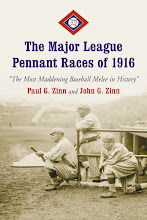
involved Adrian "Cap" Anson and two black baseball players, George Stovey and Fleetwood Walker (pictured left). Anson was a great 19th century baseball player, a hard hitting first baseman and member of the Hall of Fame. Unfortunately he was also a world class racist who gets a lot of the responsibility for the color line - the "unwritten" rule that blacks could not play in organized baseball. It is this color line that Jackie Robinson destroyed beginning in 1946 when he played with the Brooklyn Dodger farm team, the Montreal Royals.
In 1887 Stovey and Walker played with the Newark team in the International and on July 14, 1887 they were scheduled to play an exhibition game with the major league Chicago White Stockings. The question to be researched was what actually happened that day - since it was a New Jersey newspaper I volunteered to look in the Newark newspapers of the period that are housed in Alexander Library at Rutgers. As an aside I want to mention that the Alexander library has an outstanding collection of old newspapers on microfilm. Both of my books were infinitely easier to research because of the ability to use those collections. For example, they have the full runs of at least six daily newspapers for 1916 that greatly assisted our efforts to find game accounts.
It turned out that I was only able to find one Newark newspaper for 1887, the Newark Evening News. I knew the paper when back a long way, but didn't realize it was that far - the Newark Evening News was the major paper in our household when I was growing up and it lasted until the 1970's. There were two brief relevant articles in the paper for July 15th, one in the sports page (such as it was) and the other on the front page. The facts are as follows, neither Walker nor Stovey played in the game, the sports page article says that Stovey would have pitched, but he was sick.
The front page article was more illuminating, reporting that Anson had wired the manager of the Newark team (the little Giants) that his team would not play if Stovey or Walker played. No mention is then made of Walker, but the article repeats the story of Stovey being sick. However the article goes on to say that on the same day as the game, representatives of the International League teams meeting in Buffalo had directed the secretary of the league not to approve any additional contracts for blacks. No mention is made of Anson, just the comment that "Jersey City and some of the other clubs insisted that African players drove white men from the league."
When the research request appeared on the e-mail list, someone responded by saying that too much credit or blame was given to Anson for the creation of the color line - the implicit reasoning being that racism was so prevalent in America at the time that there would have been a color line with or without Anson. The articles seems to confirm that and it also seems reasonable, if Anson didn't represent to some degree the mainstream thinking it is unlikely the result would have been the same. None of this is to suggest that Anson does not deserve criticism and blame for his abhorrent attitudes.
When I wrote about the Irvington base ball club a few weeks ago, I commented on how if we in New Jersey don't tell our own history then we leave it to generalists who understandably have little interest in the New Jersey perspective. That is equally true in this case, the issue seems to be Anson and what he did or didn't do, but that doesn't address some fascinating questions/issues such as:
1. How exactly did the Newark team come to have two black players on the squad?
2. Stovey and Walker were a regular pitcher/catcher battery both before and after this incident - how did people in Newark react to what seems to be a fairly radical step?
3. Prominence in the color line drawn approved by the International League is given to the Jersey City club - Stovey pitched for the Jersey City team in the Eastern League the year before - what is that all about?
There are probably a lot of other questions that could also be asked, but once again they illustrate why what happened in New Jersey needs to be looked at from a New Jersey perspective. It is also not without some irony that Jackie Robinson's first game in organized baseball in 1946 was in the International League, a game played in, of all places, Jersey City, New Jersey.



No comments:
Post a Comment